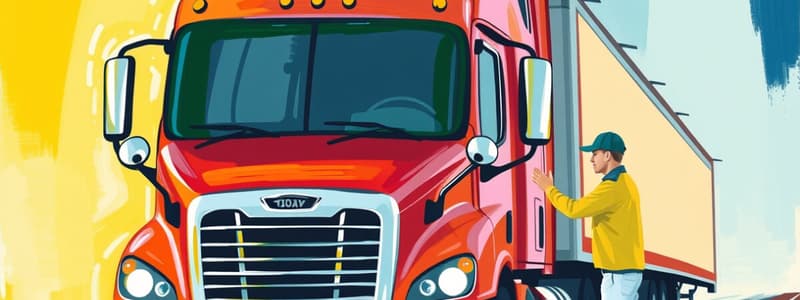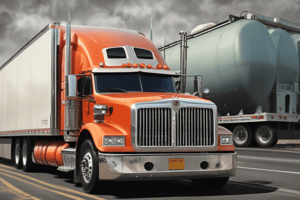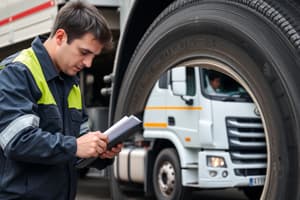Podcast
Questions and Answers
What is the most important reason for doing a vehicle inspection?
What is the most important reason for doing a vehicle inspection?
Safety
What things should you check during a trip?
What things should you check during a trip?
Watch gauges for signs of trouble. Use your senses to check for problems (look, listen, smell, and feel). Check critical items when you stop: tires, wheels, rims, brakes, lights and reflectors, brake and electrical connections to trailers, trailer coupling devices, cargo securement devices.
Name some key steering system parts.
Name some key steering system parts.
Steering wheel, tie rod, steering shaft, hydraulic fluid reservoir, gear box, pitman arm, drag link, steering knuckle, spindle, steering arm, power steering cylinder.
Name some suspension system defects.
Name some suspension system defects.
What three kinds of emergency equipment must you have?
What three kinds of emergency equipment must you have?
What is the minimum tread depth for front tires?
What is the minimum tread depth for front tires?
What is the minimum tread depth for other tires?
What is the minimum tread depth for other tires?
Name some things you should check on the front of your vehicle during the walk-around inspection.
Name some things you should check on the front of your vehicle during the walk-around inspection.
What should wheel bearing seals be checked for?
What should wheel bearing seals be checked for?
How many red reflective triangles should you carry?
How many red reflective triangles should you carry?
How do you test hydraulic brakes for leaks?
How do you test hydraulic brakes for leaks?
Why put the starter switch key in your pocket during the vehicle inspection?
Why put the starter switch key in your pocket during the vehicle inspection?
How often should cargo securement be checked?
How often should cargo securement be checked?
Why should you back toward the driver's side?
Why should you back toward the driver's side?
If stopped on a hill, how can you start moving without rolling back?
If stopped on a hill, how can you start moving without rolling back?
When backing, why is it important to use a helper?
When backing, why is it important to use a helper?
What's the most important hand signal that you and the helper should agree on?
What's the most important hand signal that you and the helper should agree on?
What are the two special conditions where you should downshift?
What are the two special conditions where you should downshift?
When should you downshift automatic transmissions?
When should you downshift automatic transmissions?
Retarders keep you from skidding when the road is slippery.
Retarders keep you from skidding when the road is slippery.
What are the two ways to know when to shift?
What are the two ways to know when to shift?
How far ahead does the manual say you should look?
How far ahead does the manual say you should look?
What are two main things to look for ahead?
What are two main things to look for ahead?
What are your most important ways to see the sides and rear of your vehicle?
What are your most important ways to see the sides and rear of your vehicle?
What does 'communicating' mean in safe driving?
What does 'communicating' mean in safe driving?
Where should you place reflectors when stopped on a divided highway?
Where should you place reflectors when stopped on a divided highway?
Where should you place reflectors when stopped on a two-way or undivided highway?
Where should you place reflectors when stopped on a two-way or undivided highway?
What three things add up to total stopping distance?
What three things add up to total stopping distance?
If you go twice as fast, will your stopping distance increase by two or four times?
If you go twice as fast, will your stopping distance increase by two or four times?
Flashcards are hidden until you start studying
Study Notes
Vehicle Inspection
- Vehicle inspections are crucial for safety.
- During a trip, monitor gauges, and use all senses (look, listen, smelly, feel) for potential issues.
- Check critical items at stops: tires, wheels, brakes, lights, connections to trailers, coupling devices, and securement devices.
Steering System
- Key components include steering wheel, tie rod, steering shaft, hydraulic fluid reservoir, gear box, pitman arm, drag link, steering knuckle, spindle, steering arm, and power steering cylinder.
Suspension System
- Common defects: movement of axle due to improper hanging, cracked spring hangers, missing/broken leaves in leaf springs, leaking shock absorbers, and damage to air suspension systems.
Emergency Equipment
- Required emergency items: fire extinguisher, spare electrical fuses, and warning devices (three reflective triangles, six fuses, or three liquid burning flares).
Tread Depth
- Minimum tread depth for front tires is 4/32 inch.
- Minimum tread depth for other tires is 2/32 inch.
Walk-Around Inspection
- During the visual walk-around, check low beams, four-way flashers, and high beams.
Wheel Bearings
- Wheel bearing seals must be inspected for leaks.
Reflective Triangles
- Carry three red reflective triangles for emergencies.
Hydraulic Brakes
- Test for leaks by pumping the brake pedal three times, then applying firm pressure for five seconds; the pedal should not move.
Safety Precautions
- Keep the starter switch key in your pocket during inspections to prevent others from moving the vehicle.
- Cargo securement should be verified after the first 50 miles and every 150 miles or every three hours, whichever comes first.
Backing Up
- Backing should be done towards the driver's side for better visibility.
- To prevent rolling back on a hill, partially engage the clutch before releasing the brake.
- Use a helper while backing to mitigate the risk associated with blind spots.
Hand Signals
- Agree on an essential hand signal with the helper: the "stop" signal.
Shifting Techniques
- Downshift before descending a hill and when entering a curve.
- Automatic transmissions should be downshifted while going downhill.
- Shift using engine speed (rpm) or road speed (mph).
Visibility and Awareness
- Look 12-15 seconds ahead while driving.
- Observe for traffic changes, road conditions, and potential obstacles (vehicles, brake lights, hills, curves).
Side and Rear Visibility
- Utilize mirrors as the primary means to see the sides and rear of the vehicle.
Safe Driving Communication
- "Communicating" in driving refers to signaling your intentions to other road users.
Reflector Placement
- On a divided highway, place reflectors 10 feet, 100 feet, and 200 feet away from the vehicle towards approaching traffic.
- On a two-way or undivided highway, place reflectors 10 feet in front or rear for corner marking, and 100 feet in front and behind the vehicle.
Stopping Distance
- Total stopping distance consists of perception distance, reaction distance, and braking distance.
- Increasing speed significantly (twice as fast) leads to a greater increase in stopping distance, specifically by four times.
Studying That Suits You
Use AI to generate personalized quizzes and flashcards to suit your learning preferences.




